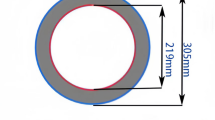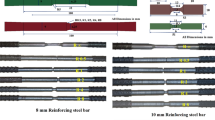Abstract
This paper examines the seismic stability of steel wide-flange columns located in the first storey of Ductile Moment-Resisting Frames (MRFs) with emphasis on their out-of-plane response and proposes improved stability design recommendations for such columns. A five-storey steel MRF is first designed in accordance with the seismic provisions of the Canadian steel design standard. A subassembly consisting of the exterior bay plus half of the adjacent interior bay is then isolated from the prototype MRF, and its finite element model is constructed. The results obtained from the nonlinear response history analysis of the MRF subassembly is used to assess the stability response of the first-storey columns and verify the adequacy of a component-based column model, which is isolated from the MRF, in predicting column nonlinear cyclic response. A total of 26 seismically-compact wide-flange columns covering a wide range of geometrical parameters, including global slenderness, cross-section aspect and section width-to-thickness ratios, are subjected to cyclic strong-axis displacement and weak-axis bending in the presence of a constant axial compression load. The results of the column parametric study are used to identify column out-of-plane instability modes using strength and deformation response parameters, including base moment, axial shortening, out-of-plane displacement, and cross-section twist. Two instability modes, including out-of-plane buckling at the base and member buckling, are observed. A design equation as a function of parameters affecting the out-of-plane stability of columns with base plastic hinging, namely global slenderness, cross-section aspect and axial load ratios, is finally proposed to verify the out-of-plane stability of first-storey columns under seismic loading.












Similar content being viewed by others
Data Availability
Not applicable.
Code Availability
Not applicable.
References
AISC (2016a) Seismic provisions for structural steel buildings. ANSI/AISC 341 – 16. American Institute of Steel Construction
AISC (2016b) Code of standard practice for steel buildings and bridges. ANSI/AISC 303 – 16. American Institute of Steel Construction
AISC (2016c) Prequalified for special and intermediate steel moment frames for seismic applications, ANSI/AISC 358 – 16. American Institute of Steel Construction, In. Chicago, IL, USA
ASTM (2003) Standard specification for general requirements for rolled structural steel bars, plates, shapes, and sheet piling, ASTM A6/A6M-04b. American Society for Testing and Materials
Brownlee SA (1994) Axial force and plate slenderness Effects on the Inelastic Behaviour of Structural Steel Beam-Columns. the University of Canterbury, Christchurch, New Zealand
CEN (2003) Eurocode 8 – design provisions for earthquake resistant structures, EN-1998-1:2003. E, Comite Europeen de Normalization, Brussels, Belgium
CSA (2019) Design of steel structures. Canadian Standards Association Group. Mississauga, ON, Canada
Chi B, Uang C-M (2002) Cyclic response and design recommendations of reduced beam section moment connections with deep columns. J Struct Eng 128(4):464–473
CISC (2014) Moment Connections for Seismic Applications, 2nd Edition. Canadian Institute of Steel Construction. Markham, ON, Canada
CISC (2021) Handbook of steel construction. Canadian Institute of Steel Construction. Markham, ON, Canada
Cravero J, Ahmed E, Lignos D (2020) Experimental evaluation and numerical modeling of wide-flange steel columns subjected to constant and variable axial load coupled with lateral drift demands. J Struct Eng 146(3):04019222
Dassault Systemes Simulia Corporation (2020)ABAQUS-FEA/CAE. In. RI, USA
de Castro e Sousa A, Suzuki Y, Lignos DG (2020) Consistency in solving the Inverse Problem of the Voce-Chaboche constitutive model for Plastic Straining. J Struct Eng 146(9):04020097
Elkady A, Lignos D (2014) Modeling of the composite action in fully restrained beam-to-column connections: implications in the seismic design and collapse capacity of steel special moment frames. Earthq Eng Struct Dynamics 43(13):1935–1954
Elkady A, Lignos D (2017) Stability requirements of deep steel wide-flange columns under cyclic loading. Proceedings of the Annual Stability Conference Structural Stability Research Council, San Antonio, Texas, USA
Elkady A, Lignos DG (2018a) Full-scale testing of deep wide-flange steel columns under multi axis cyclic loading: loading sequence, boundary effects, and lateral stability bracing force demands. J Struct Eng 144(2):04017189
Elkady A, Lignos DG (2018b) Improved seismic design and nonlinear modeling recommendations for wide-flange steel columns. J Struct Eng 144(9):04018162
FEMA (2000) State of the art report on connection performance, FEMA-355D. Federal Emergency Management Agency
Hartloper AR, de Castro Sousa A, Lignos DG (2021) Constitutive modeling of Structural Steels: nonlinear Isotropic/Kinematic hardening material model and its calibration. J Struct Eng 147(4):04021031
Imanpour A, Lignos D, Clifton C, Tremblay R (2016) Comparison of seismic design requirements for steel moment resisting frames with emphasis on stability of columns in North America, New Zealand, and Europe. 11th Pacific Structural Steel Conference, Shanghai, China
Islam A, Imanpour A (2022) Stability of wide-flange columns in steel moment-resisting frames: evaluation of the canadian seismic design requirements. Bulletien Earthq Eng 20:1591–1617
Islam A (2022) Improved seismic design recommendations for wide-flange columns in ductile steel moment-resisting frames considering three-dimensional response. Department of Civil and Environmental Engineering, University of Alberta, Canada
MacRae GA, Carr AJ, Walpole WR (1990) The seismic response of steel frames, Report 90 – 6. University of Canterbury Research, University of Canterbury, Christchurch, New Zealand
McKenna F, Fenves GL, Scott MH (1997) Open System for Earthquake Engineering Simulation (OpenSees). In. University of California, Berkeley
Mokhtari M, Islam A, Imanpour A (2022) Development, seismic performance and collapse evaluation of steel 616 moment-resisting knee braced frame. J Constr Steel Res 197:107262
Nakashima M, Takanashi K, Kato H (1990) Test of steel beam-columns subject to sidesway. J Struct Eng 116(9):2516–2531
Newell JD, Uang C-M (2008) Cyclic behavior of steel wide-flange columns subjected to large drift. J Struct Eng 134(8):1334–1342
NRC (2015) National Building Code of Canada 2015. National Research Council of Canada
NRC (2015) User’s guide – NBC 2015 structural commentaries (part 4 of Division B). Associate Committee on the National Building Code, Ottawa, ON
NZS (1997) Steel structures standard, NZS 3404: Part 1:1997. Standards New Zealand, Wellington, New Zealand
Ozkula G, Harris J, Uang C-M (2017a) Observations from cyclic tests on deep, wide-flange beam-columns. Eng J Am Inst Steel Constr 54:45–60
Ozkula G, Harris J, Uang C-M (2017b) Classifying cyclic buckling modes of steel wide-flange columns under cyclic loading. ASCE Structures Congress, Denver, CO, pp. 155–167
Ozkula G, Harris J, Uang C-M (2017c) Cyclic backbone curves for steel wide-flange columns: a numerical study. Ce/Papers 1(2–3):3365–3374
Ozkula G, Uang C-M, Harris J (2021) Development of enhanced seismic compactness requirements for webs in wide-flange steel columns. J Struct Eng 147(7):04021100
Penga BHH, MacRae GA, Walpole WR, Moss P, Dhakal RP, Clifton C, Hyland C (2008) Location of plastic hinges in axially loaded steel members. J Constr Steel Res 64:344–3516
Popov EP, Bertero VV, Chandramouli S University of California, B. E. E. R. C. (1975). Hysteretic behavior of steel columns.Earthquake Engineering Research Center, University of California, CA, USA
Popov EP, Yang T-S, Chang S-P (1998) Design of steel MRF connections before and after 1994 northridge earthquake. Eng Struct 20(12):1030–1038
Ricles JM, Zhang X, Lu L-W, Fisher JW (2004) Development of seismic guidelines for deep column steel moment connections. AISC/ATLSS Report No, Lehigh Univ., Bethlehem, PA, pp 04–13
Shen J, Associate S, Astaneh-Asl A, McCallen D (2002) Use of deep columns in special steel moment frames. Steel Tips, Structural Steel Educational Council
Suzuki Y, Lignos DG (2021) Experimental evaluation of steel columns under seismic hazard-consistent collapse loading protocols. J Struct Eng 147(4):04021020
Tremblay R, Atkinson GM, Bouaanani N, Daneshvar P, Leger P, Koboevic S (2015) Selection and scaling of ground motion time histories for seismic analysis using NBCC 2015. The 11th Canadian Conference on Earthquake Engineering, Victoria, BC, CA
Uang C-M, Ozkula G, Chansuk P (2019) Research on seismic design of deep wide-flange steel columns in the U.S. 12th Pacific Structural Steel Conference, Tokyo, Japan, Tokyo, Japan
Yu QS, Gilton C, Uang CM, Sac JV (2001) Cyclic response of RBS moment connections: Loading sequence and lateral bracing effects, Rep. No. SSRP-99/13. Dept. of Structural Engineering, Univ. of California, San Diego, CA
Zhang X, Ricles JM (2006) Experimental evaluation of reduced beam section connections to deep columns. J Struct Eng 132(3):346–357
Zareian F, Lignos DG, Krawinkler H (2010) Evaluation of seismic collapse performance of steel special moment resisting frames using FEMA P695 (ATC-63) methodology. ASCE Structures Congress, Orlando, FL, May 12–15, pp 1275–1286
Acknowledgements
Financial support provided by the Natural Sciences and Engineering Research Council (NSERC) of Canada is acknowledged. The authors wish to express their gratitude to the Steel Centre at the University of Alberta for their support. The authors would like to extend great thanks to Professor Dimitrios Lignos of École Polytechnique Fédérale de Lausanne (EPFL) and Professor Ahmed Elkady of the University of Southampton for sharing the test data. Finally, the authors wish to thank the reviewers for their cogent and constructive comments, which led to improve the quality of the paper.
Funding
This study was funded by the Natural Sciences and Engineering Research Council (NSERC) of Canada.
Author information
Authors and Affiliations
Corresponding author
Ethics declarations
Conflicts of Interest
The authors declare they have no relevant financial or non-financial interests to disclose.
Ethics approval
Not applicable.
Consent to participate
Not applicable.
Consent for publication
Not applicable.
Additional information
Publisher’s Note
Springer Nature remains neutral with regard to jurisdictional claims in published maps and institutional affiliations.
Rights and permissions
Springer Nature or its licensor (e.g. a society or other partner) holds exclusive rights to this article under a publishing agreement with the author(s) or other rightsholder(s); author self-archiving of the accepted manuscript version of this article is solely governed by the terms of such publishing agreement and applicable law.
About this article
Cite this article
Islam, A., Imanpour, A. Seismic stability of steel wide-flange columns in ductile moment-resisting frames: out-of-plane response and design recommendations. Bull Earthquake Eng 21, 3493–3519 (2023). https://doi.org/10.1007/s10518-023-01653-7
Received:
Accepted:
Published:
Issue Date:
DOI: https://doi.org/10.1007/s10518-023-01653-7




